A food chain is a simple way to show the flow of energy in an ecosystem. Each step in the food chain represents an organism that gets its energy by consuming the previous one. A producer traps the solar energy and then provides the basic food or energy for all the other life forms in the ecosystem The consumers or animals derive their energy needs directly or indirectly from the producers (plants).
When these producers and consumers die, the decomposers act on their bodies and return all the various elements back to the soil, air, and water. The decomposers help in recycling the materials in the ecosystem so that the process of life may go on and on like an unending chain. In biology, the study of the food chain in an area or habitat helps us to know various interactions among the different organisms and also explains their interdependence.
Define Food Chain
Anything that we eat to live is called food. Food contains energy, the food (or energy) can be transferred from one organism to the other organism through the food chains. The starting point of a food chain is a category of organisms called Producers. Producers are, in fact, plants. So, we can say that almost the food chain begins with a green plant (or grass) which is the original source of food. Let us take an example to understand the meaning of the Food Chain.
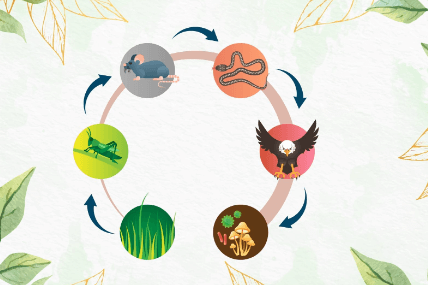
In a field with many green plants, a food chain begins. First, insects eat the plants. Then, rats eat the insects. After that, snakes eat the rats, and birds eat the snakes. When the birds die, decomposers break them down. This shows how each living thing relies on another for food. Each step in this chain helps move energy from one organism to another, keeping nature balanced and helping all living things find the food they need.
The Food Chain is the sequence of living organisms in a community in which one organism consumes other organisms (living beings) to transfer food energy. In simple words, A Food Chain is a list of organisms (living organisms) that shows “Who Eats Whom”.
Major Parts of the Food Chain
A food chain shows how energy moves from one living thing to another. It starts with plants, which make their own food using sunlight. Here we have discussed almost all the major parts of the food chain that help in its proper functioning and energy transportation.
| Some Major Parts of the Food Chain | |
| Parts | Description |
| Sun | The sun is the primary energy source for photosynthesis. |
| Producers | The producers convert solar energy into food (photosynthesis). |
| Consumers | The consumers depend on producers for energy and nutrients. |
| Decomposers | The decomposers help in the breakdown of organic matter and recycle nutrients in an ecosystem |
Sun:
The sun is the primary source of energy, driving photosynthesis in plants. This process forms the basis of the food chain, sustaining life by providing essential energy.
Producers:
Mostly producers are plant and blue-green algae. These plants and algae prepare their own food with the help of Photosynthesis, using sunlight, water, and carbon dioxide. They form the base of the food chain, providing energy to all the other living organisms in an ecosystem.
Consumers:
Consumers are living things that eat other organisms for energy. In nature, they include animals and some plants. They are divided into many categories such as primary consumers (eat plants), secondary consumers (eat other animals), and tertiary consumers (eat other animals).
| Different Types Consumers | |
| Types | Description |
| Primary Consumers | Primary consumers feed on producers. All the herbivore comes under primary consumers (for example: rabbits, deer, etc). |
| Secondary Consumers | Secondary consumers feed on primary consumers. Secondary consumers include almost all the carnivores (for example: foxes, snakes, etc.). |
| Tertiary Consumers | Tertiary consumers feed on secondary consumers. Almost all apex predators come under tertiary consumers (for example: eagles, lions, etc) |
- Primary Consumers: These are often called herbivores. These organisms directly feed on plants or other producers. They play a very crucial role in transferring energy from plants to higher levels of the food chain.
- Secondary Consumers: Secondary consumers are organisms in a food chain that feed on primary consumers or other herbivores. They occupy the next level of the food chain and play a crucial role in balancing ecosystem populations.
- Tertiary Consumers: These are organisms that are present at the top of the food chain and primarily feed on secondary consumers. They help to regulate the populations of lower tropic levels and also contribute to the proper balance of the ecosystem.
Decomposers:
Decomposers are organisms that break down dead plants and animals or organic matter from all tropical levels into simpler substances. They include bacteria, fungi, and some insects. Decomposers play a crucial role in the ecosystem by recycling nutrients back into the soil, which plants use to grow. Without decomposers, dead material would accumulate, and the nutrients needed for new plants to grow would be locked away, disrupting the balance of the ecosystem.
Types of Food Chains
Food chains are connected to each other and form complex food webs. These food webs help us understand how different living things depend on one another in nature. Based on the roles of organisms, food chains are divided into three types: Grazing Food Chain, Detritus Food Chain, and Parasitic Food Chain. Each type shows a different way energy flows in an ecosystem. Let’s take a quick look at each type to understand how they work and how organisms interact in different ways.
| Different Types of Food Chains | |
| Types | Description |
| Grazing Food Chain | Energy flow starts with green plants, which are consumed by herbivores, followed by carnivores. Common in terrestrial ecosystems. |
| Detritus Food Chain | Energy flow begins with dead organic matter broken down by decomposers, then consumed by detritivores. Common in decomposition processes. |
| Parasitic Food Chain | Involves parasites living on or in a host organism, deriving nutrients from the host’s body. Controls host populations and plays a role in ecosystem balance. |
Detritus Food Chain
The detritus food chain focuses on the decomposition of organic matter, as it involves organisms that break down and feed on decaying plants, animals, and other organic material. The decomposers such as fungi, and different types of insects are at the base of the detritus food chain.
These decomposers help in the breaking of complex organic molecules into simpler substances, and release nitrogen (through the nitrogen cycle), phosphorus (through the phosphorus cycle), and carbon (through the carbon cycle) back into the atmosphere. The detritus food chain is very important for nutrient recycling in the ecosystem. Its main function is to highlight the importance of decomposers in our environment.
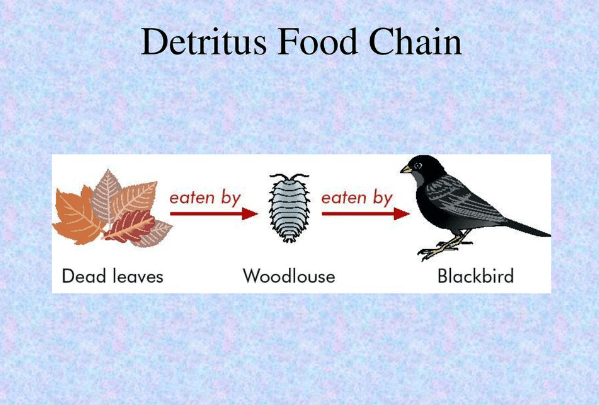
Grazing Food Chain
The grazing food chain is also known as the Predator-prey food chain, as it represents the transfer of energy and nutrients through the consumption of living organisms. The grazing food chain explains the relationship between predators and their prey. In the grazing food chain, the chain starts with the producer such as plants which converts sunlight into energy through photosynthesis.
And ends with the consumers, these consumers can be further divided into primary, secondary, and tertiary consumers based on their position in the food chain. A grazing food chain helps regulate population size and maintain the balance between different species.
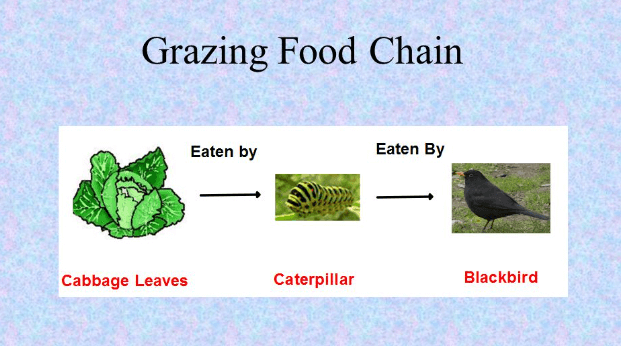
Parasitic Food Chain
Parasitic food chains involve organisms living in or on a host organism and deriving nutrients at the host’s expense. The energy flow starts with the host, which is then consumed by a parasite. The parasite derives its energy and nutrients from the host organism. This type of food chain is common in ecosystems where parasites play a significant role in controlling populations of other organisms.
Examples of Food Chain
In the above food chain, there were three organisms involved: Grass, Deer, and Lion, so it is said to be a food chain having three steps or three links. A grassland or forest consists of many different organisms, so it has many other food chains operating in it which have different numbers of steps. Now let’s have a four-step grassland food chain example. In a grassland ecosystem grass is eaten up by insects; these insects are eaten by the frogs and lastly, these frogs are consumed by the birds. This food chain can be represented as:
Grass → Insects → Frog → Snake → Bird
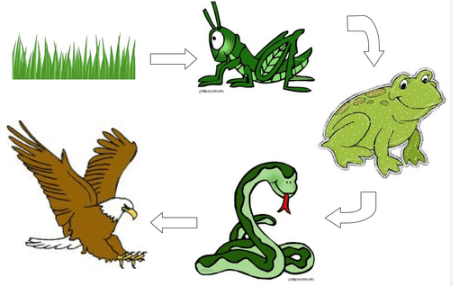
In a grassland food chain, grass grows as the producer. Insects eat the grass as primary consumers. Frogs eat the insects as secondary consumers, while snakes eat the frogs as tertiary consumers. Birds are the top consumers.
Now let us take an example of the food chain that is operated in the aquatic ecosystem (water ecosystem) like ponds, lakes, rivers, or seas. In a pond, lake, or sea ecosystem, the algae also known as phytoplankton are eaten by tiny creatures called protozoa or zooplankton. These small creatures are then eaten by small fish, which are later eaten by larger fish.
Algae (producer) → Protozoa (herbivore) → Small fish (carnivore) → Big fish (top carnivore)
Humans are at the end of most of the food chains in which they occur. But sometimes luck runs out of humans’ hands and they are forced to become food for others. A food chain is a great miracle of God in which ” A Hunter becomes Hunted”.
Other Important Points About Food Chain
Let us make the food chain more clear with a simple example of a grassland or forest food chain. In a grassland or forest, there is a lot of grass (which is a green plant). This grass is eaten up by various herbivores like deer. And then this deer or herbivore is consumed or eaten up by a lion or other carnivores. This is the simplest example of a forest food chain and it can also be written as:
Grass (producer) → Deer (herbivore) → Lion (carnivore)

Important Points about the Food Chain
- Food Chain represents a single-directional or unidirectional flow of energy. For example, the above food chain tells us that the transfer of energy takes place from grass to deer and then to lion.
- The food chain can not take place in the reverse direction from lion to deer to grass.
- It is very important to note that each organism occupies a specific position in the food chain. for eg. grass, deer, and lion occupy a specific position in the food chain.
- One organism can occur in more than one food chain. For e.g., in the forest food chain, a deer may be consumed either by a lion, tiger, or jackal.
- In an aquatic food chain the producer is a minute organism called Algae and Protozoa is also a minute herbivore.
Food Web
A very large number of food chains exist in our ecosystem such as a grassland, a forest, a pond, or a crop field. As we already discussed one organism can be present in more than one food chain, these organisms form an interconnection between many food chains.
So these interconnected food chains operating in an ecosystem that establish a network of relationships between various species of organisms is known as a food web. This tells us that various food chains in an ecosystem do not operate alone, they operate in the form of a network of food chains called food webs. There may be six, seven, or more food chains operating in a single Food Web.
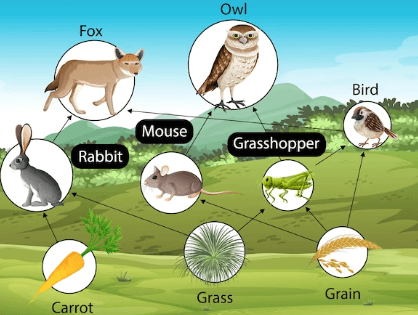
Trophic Levels
As for now, we all know that the food chain represents the flow of energy or food in a set of organisms. The various steps in a food chain at which the transfer of food or energy takes place are called trophic levels. In fact, in a food chain, each step representing an organism forms a trophic level. In simple words, you can say that the term “trophic level” means the “feeding level” of an organism. Various trophic levels in a food chain can be represented as:
- The plants, are producers or autotrophs and form the first trophic level. They fix up the sun’s energy for the consumers or heterotrophs.
- Herbivores or primary consumers form the second trophic level.
- The carnivores or secondary consumers form the third trophic level.
- And the top carnivores or tertiary consumers constitute the fourth trophic level.
Now let us explain the tropic level with the help of the simple food chain that we have already studied :
Grass → Deer → Lion
This food chain has three trophic levels. Grass (being producers) present at the first trophic level, deer (being herbivores) represent the second trophic level, and lions (being carnivores) represent the third tropic level. Let us take another eg. of another food chain that only involves plants and men. This type of food chain has only two trophic levels, with which plants representing the first trophic level and Men representing the second tropical level.
The trophic level in a food chain can also be represented by a pyramid of numbers. It means that if we count the number of species (or organisms) living at each tropic level in a food chain, then we can represent the food chain by a pyramid of numbers.
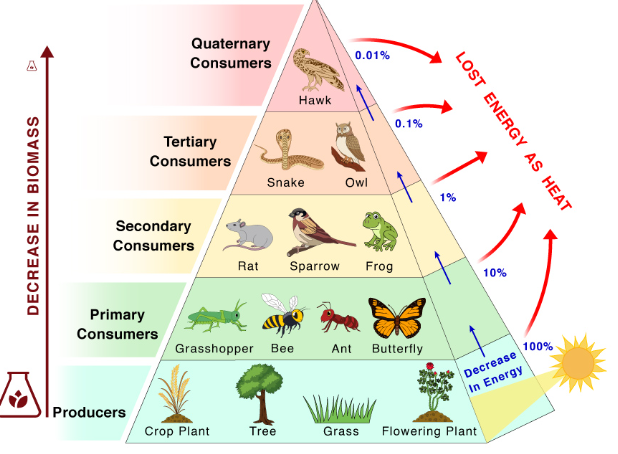
Ten Percent law
During energy transfer through the trophic levels in an ecosystem, there is a loss of energy. No transfer of energy is 100 percent, as there is a uniform pattern of transfer of energy which is given by the 10 percent law. This 10 percent law was given by Lindeman in the year 1942, the 10 percent law is one of the most useful phenomena which helps us to check the magnitude of the loss of energy in the food chain.
According to the 10 Percent Law, only 10 percent of energy entering a particular trophic level of organisms is available for the transfer of energy to the next higher trophic level. We can also say that the energy available at each successive trophic level is 10 percent of the previous level.
For more details, you can also go through our article on Difference Between Food Chain and Food Web

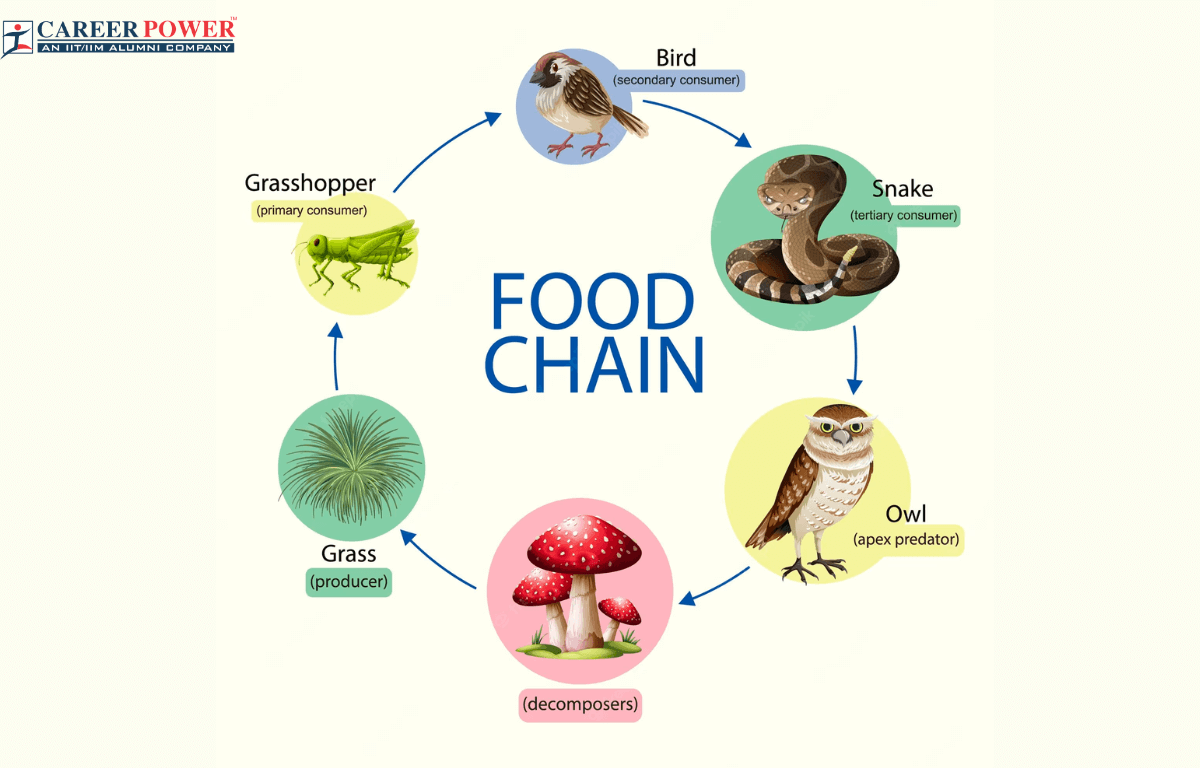

 50 Vegetables Name for Kids in English a...
50 Vegetables Name for Kids in English a...
 Human Respiratory System: Definition, Di...
Human Respiratory System: Definition, Di...
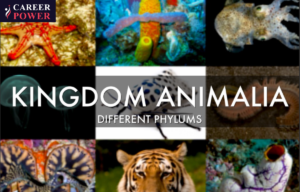 Animal Kingdom: Classifications, Example...
Animal Kingdom: Classifications, Example...













